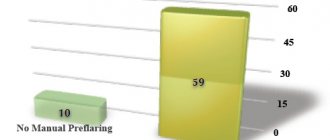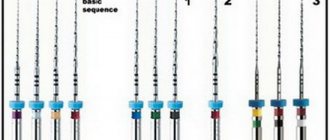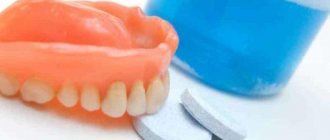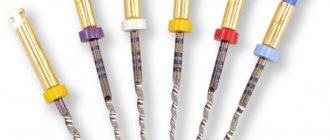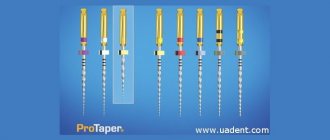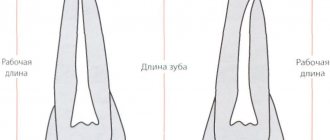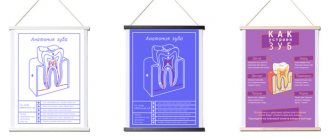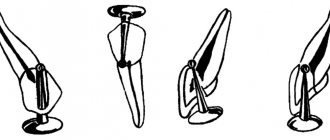General presentation and purpose
Profiles are instruments used for endodontic treatment. The full and official name is “Profile.04 Taper Series 29 Rotary Instruments”.
Initially, instrument sets were produced by the American company Tulsa Dental Product. Later, in tandem with the Maillefer company, the production of similar sets began in Sweden.
The difference lies in the optimization of products to ISO standards using European encodings and colors.
In dentistry, profiles are used for gradual expansion of root canals.
Characteristics
Profiles are made of nickel (56%) and titanium (44%). Practice has shown that an alloy with the specified proportions gives flexibility to the product. This property is important in endodontic work, since the passages of the root canals are not straight, but curved.
The alloy is also known as nitinol, an erosion and corrosion resistant material. In addition to all its advantages, the alloy is also useful for its shape memory ability. The material is sensitive to sodium hypochloride - with constant contact, the instrument is destroyed.
According to the creators' concept, the profiles have a taper of 4% and 6%. The level is designated as 04 and 06. The given numbers mean an increase in diameter by 0.04 and 0.06 mm for each millimeter of the product, respectively. The diameter of each subsequent tool is 29% wider than the previous one.
A cross-section shows that the spiral is made with U-shaped grooves . The role of the grooves is to clean the hole made.
Thanks to the spiral structure, all cut fragments come out through grooves. On the outside, the spiral creates flat walls, which is necessary for a straight course of movement when drilling.
Another feature of the profiles is the presence of a non-aggressive top . When compared with the aggressive tip, the rounded tip of the instrument is noticeable - BAT Ttip. This structure reduces trauma and perforation of the apical region.
Predecessors
Nickel-titanium tools of the first generation were characterized by low cutting ability.
Representatives of this generation, ProFile and GT Rotary files, had a radial surface that occupied the width of the root canal and was characterized by a high friction force. They were classified as passive devices. They often broke during operation. K-3 technology has made it possible to create unique rotating tools. They were distinguished by a design that reduced the fragility of the device and the friction force in the root canal. This design was minimized in terms of contact area and blade base width. After K-3, improved Protapers appeared. Their design made them active, this was achieved by a cross section that provided contact with the channel at 3 points.
The Mtwo tool has a low friction force, which is ensured by the cross-sectional shape. The S-shape ensures contact when passing through the root canal at 2 points. This reduces the stressful vibration of the device itself during operation.
Kinds
The complex task of the profile is to pass the root canal with gradual expansion and cleaning of the passages.
Basic set
The main set of profiles is called Pro File Basic Seguency Kit. The kit consists of profiles with a 25mm working part. The components of the set have U-shaped grooves and non-aggressive tops.
The handles of machine and hand profiles have color rings that comply with ISO standards.
The kit includes a plastic handle that allows you to work the machine profile manually:
- estuarine – used to increase the width and depth of the root canal mouth and facilitate the passage of subsequent profiles;
- profiles with a taper of 0.6 are indicated by colors on the shank - yellow - 1 pc., d=0.20 mm; red – 1 pc., d= 0.25 mm; blue – 1 pc., d=0.30 mm.
- for profiles with a taper of 0.4, the shanks are painted accordingly - yellow with a diameter of 0.20 mm (1 pc.); red – with a diameter of 0.25 mm (1 pc.); blue – with a diameter of 0.30 mm (1 pc.).
- K-type manual dilators with a taper of 0.2 mm, made of nitinol.
The handle of the tools is comfortable to use. The handle and the working part are connected by spot welding. Under heavy loads on the profile, refraction will occur in this part. This type of instrument is used for initial movement along the root canal.
Features of dental restoration with Gradia Direct fillings and tactics of the procedure.
Come here if you are interested in how root canal obturation is performed with gutta-percha.
At this address https://www.vash-dentist.ru/lechenie/zubyi/plombyi/tsvetnyie-twinky-star.html we will tell you about the advantages of Twinky Star colored fillings.
Additional profiles
Profile Orifice Shaper is used to expand the mouth of the root canal. Thanks to the rounded tip, the passage into the canal has the shape of a wide funnel.
Profile OS are made of nitinol alloy and the product length is 19 mm.
Divided into:
- yellow – with diameter 06/20 (1 pc.);
- red – with diameter 06/40 (1 pc.);
- blue – with diameter 07/50 (1 pc.).
Intro Case Profile is intended for introductory procedures. The kit contains:
- Educational videos.
- Set of nickel-titanium profiles.
- Special endodontic tip.
- Training blocks for learning how to use the tool.
GT Rotary files
- Material – nitinol;
- Rotation – 200-350 rpm clockwise;
- A distinctive feature is that the taper of the working module is increased.
The GT Rotary Files set is presented in three sets:
The first set is the basic tools:
- has two-color markings on the shank;
- designed to perform manipulations using the Crown Down method;
- instruments have lengths of 21 and 25 mm;
- different taper from 6% to 12%;
- identical tip diameter equal to 0.20 mm;
- the set consists of 4 units.
The second set is apical instruments:
- the shank is painted with one color ring;
- used to treat the apical section of the root canal;
- The length of the apical instruments is determined by the ISO standard. It is 21; 25; 31 mm;
- taper of all units – 4%, or (.04);
- tip diameter varies from ISO No. 20 to No. 35;
- The set contains 4 tools.
Third set - wellhead tools:
- There are no color rings on the shank;
- The main task is to sharpen the mouth to the shape of the funnel;
- Same taper for all tools - 12%(.12);
- 35, 50, 70 mm – standard ISO sizes;
- The length varies in the range of 21-25 mm.
Pro Taper System
Designed for treating hard-to-reach areas of root canals. Difficulty in access is caused by either high calcification or excessive curvature of the root canal.
The kit includes 6 tools, divided into 2 groups:
- Shapers (shapers) – are able to change the shape of the channel to the required limit. Includes the following types - Sx (forms short channels), S1 (forms the upper third of the channels) and S2 (forms the middle third of the channels);
- Finishers (finishing formation of the apical part of the canal). Kit includes F1 (d=0.20, taper=.07%),F2 (d=0.25, taper=.08%),F3 (d=0.30, taper=.09%)
- Made of nickel and titanium alloy;
- In cross section, a convex triangular shape is determined;
- Increasing taper makes the tool as flexible and effective as possible in clearing the canal from cut out fragments.
СiТ Rotary Files
- Material – nickel-titanium alloy;
- Rotation speed is limited to 150-350 rpm;
- When working, it is important to use a lowering endodontic handpiece and a micromotor with a reduced speed level;
- The taper of the working area has been increased.
Flex Master System
The Flex Master endodontic system consists of:
- nickel-titanium Flex Master files;
- taper .02 (1 ring on handle), .04 (2 rings), .06 (3 rings);
- electric motor "VDW EndoStepper";
- system box;
- notepad for recording information about the operation of files.
The cross-section of the instruments is convex-triangular. This form is characterized by wear resistance, productivity during passage and a minimal level of curling.
When working, the Crown Down method is used. To determine the depth of the channel there are black notches located at a distance of 18, 19, 20, 22 mm from the cutting tip.
Purpose and packaging of Estelite filling material, instructions for use.
From this publication, find out what material is used for retrograde root canal filling.
Here https://www.vash-dentist.ru/lechenie/zubyi/plombyi/vozmozhnosti-materiala-filtek.html you will find fair reviews about the Filtek filling material.
KZ Endo
The K3 Endo system is distinguished by an asymmetrical triangular blade. This structure minimizes the possibility of decentralized entry into the channel , protects against breakdowns and increases the speed of operation.
The tip of the tool is non-cutting and non-aggressive. The presence of a short handle makes it easier to work with chewing teeth.
Mtwo endodontic instruments
Mtwo sets are produced by VDW (Munich, Germany)
The kit includes tools under different numbers:
- #25 – tip taper .06;
- #20 – tip taper .06;
- #15 – taper .05;
- #10 – taper .04
The kit also includes MtwoA for apex treatment and Mtwo R for re-treatment. The length of the tools is 21; 25 and 31 mm.
The cross section shows an S-shaped section with two cutting edges. The top of the instruments is non-aggressive. It does not cut, but only guides the tool.
Overview of Mtwo endodontic files
Using the functional and easy-to-use new generation Mtwo NiTi files from the German manufacturer VDW, you can shape and clean even the most difficult-to-reach channels.
Advantages of Mtwo:
- Faster treatment - you can go through the area, remove the pulp and form a canal at the same time;
- Shape memory effect;
- The flexible design ensures easy passage of the channel, taking into account its structure;
- Durable nickel-titanium alloy reduces the likelihood of file fracture;
- The files do not have a negative effect on the tooth structure, gently affecting the tissue while preserving healthy areas.
Features of Mtwo files
S-shaped section and maximum flexibility
Less chance of plugging due to S-shaped section. The file almost does not come into contact with the walls of the root canal, preserving more space for the removal of dentin filings.
The S-shaped cross-section of the tool is formed by two active cutting blades, which give it this specific shape. Each blade is a long, almost vertical spiral, which gives the tool a double cutting effect and allows progress along the canal.
Uneven blade placement
Safe processing due to the uneven distance between the blades, which decreases closer to the tip of the tool. This allows the tip to gently remove pulp and the handle to form a channel without allowing dentin chips to accumulate.
Two cutting edges and an inactive tip
Sharp blades have minimal impact on the tooth walls and successfully remove areas of calcification without requiring additional pressure on the instrument. The Mtwo tip is not screwed in, but is pushed safely along the natural morphology of the canal. This allows you to safely clean even curved root canals. The shank is shortened by 5 mm to provide more space for file insertion.
Convenient marking
Quickly measure the correct diameter and taper using convenient markings, and controlled preparation thanks to penetration depth marks. The color of the stripe on the shank corresponds to the ISO size of the tool.
| Top diameter | 0.06 mm | 0.08 mm | 0.10 mm | 0.15 mm | 0.20 mm | 0.25 mm | 0.30 mm | 0.35mm | 0.40 mm |
| Color coding | 06 | 08 | 10 | 15 | 20 | 25 | 30 | 35 | 40 |
There is a ring taper marking on the shank:
- 1 ring – taper 4%
- 2 rings – 5% taper
- 3 rings – 6% taper
- 4 rings – 7% taper
Buy Mtwo files
Application
The channel is processed quickly due to the high operating speed (from 250 to 350 rpm). It is important to remember that you need to check files for suitability before use. If a file shows signs of excessive stress, it should not be reused. During processing, also do not press on the file on the endomotor.
To process the canal using the Mtwo method in the “one length technique”, 4 tools are used: 10/.04, 15/.05, 20/.06, 25/.06.
- 10/.04 is necessary to create a cone-shaped expansion in the canal over the full working length. After which 15/.05 is used.
- For the final formation of the channel, you will need 25/.06 and 20/.06 with an increased distance between the turns.
- The Mtwo series also includes tools with larger sizes - 30/.05, 35/.04 and 40/.04. for cases where the apical part is more than 25 ISO.
- Typically, sawing occurs automatically, as it passes to the top of the root. If the file is advanced with some force, the manufacturer recommends removing it 1-2 mm and further processing the canal with sweeping movements.
Mtwo systems also have a special SYSTEM BOX organizer, where all files are located in the correct sequence. There is no need to waste time searching for the right tool.
The Mtwo endodontic treatment method is an easy and effective canal preparation with greater safety and speed of treatment.
Standard tool operation
The use of profiles involves using a rotation speed in the range of 200-350 rpm.
The profile is inserted into ½ of the working part using the crown-down method. This helps to quickly reach the apical zone. It is preferable to work in the apical part using the “Step Back” technique.
For example, the use of Mallifer .04 profiles must meet the following requirements:
- Micromotor rotation speed – 150-350 rpm;
- The presence of reducing tips that stably retain the rotational power when the speed decreases.
Recommended sequence of endodontic actions:
- An x-ray must first be taken to examine the working length, the canal type, and the presence of apical foramina;
- Then profile 04. N25 (with the red mark) enters a third and then half the length of the channel at a rotation speed of 250 rpm
- The tool is replaced with 04. N30 (with a blue mark) and is also sequentially inserted to the previous depth.
- Next, profile N20 (with a yellow mark) is introduced into the channel , but only 3/4 of the channel length.
- Now comes the turn of operating with a manual K-file (N10-15). This is necessary to correctly determine the channel length. The correct method is to use an apex locator. If resistance occurs with light pressure, then repeat the manipulations described above.
- When the working length is reached, it is necessary to widen the canal with larger tool sizes (N20, then N25, etc.) until the canal size and final profile are equal.
If working with profiles has not yet become a habit, then to reduce the risk it is better to pass the last 2-3 mm remaining to the apical foramen manually, without the help of machine rotation.
Systematic irrigation of the canal with a 2.5% sodium hypochloride solution is recommended.
One profile is used in 6-8 channel operations. After this, it must be disposed of to avoid “metal fatigue”, leading to deformation or destruction of the tool.
Features of the MTWO (MTU) system from VDW
A truly revolutionary event was the appearance of the M2 system on our market. Professor Vito Antonio Malanino, the creator of this system, is himself a practicing physician, the goal of his work was to ensure that there are no more impassable canals.
Of course, if he could not change the anatomical and morphological features of his patients' root canals, he could change the way they were treated, and he had to change it. The M2 system delights with its combination of simplicity, functionality and efficiency. This is a new concept of NiTi tools, the characteristic features of which are:
Design features of Mtwo
The S-shaped cross-section with two cutting edges provides:
- minimal lateral contact between the tool and the channel wall, due to which the tool produces cutting rather than friction
- maximum space for removing dentinal filings
- longest period of tool operation under load (high fracture resistance)
- torsional load on the channel walls at only two points.
The increased space between the blades provides:
- excellent recopitulation of dentinal filings, which virtually eliminates the risk of dentinal plug formation (borer system)
- reduction of torsion load on metal
- increased flexibility and efficiency
Unevenly spaced blades
The distance between the cutting blades increases from the tip of the tool to the handle. More frequent threading at the tip of the instrument eliminates infection at the apex, and less frequent threading at the base of the instrument creates a channel. The progressive blade and dentin removal space are deeper on the inner surface of the blade, helping to minimize the risk of blocking and accumulation of dentin chips.
Both edges of the blade are cutting , which allows these instruments to be classified as active, but they cannot in any way be called aggressive. This means that when M2 is used, gentle preparation of the canal walls occurs (tooth-saving technology), while the presence of instruments 05 and 07 The taper allows for simultaneous passage, necrotomy, and canal formation. As a result, the time for instrumental channel preparation is significantly reduced.
M2 instruments have a dual cutting action: at penetration depth and laterally. This enables what is called “simulation shaping.”
The cutting efficiency of the lateral surfaces, directed forward and laterally, allows you to eliminate areas of calcification that interfere with access to the canal in the pulp chamber or coronal third of the canal without additional pressure on the instrument.
The presence of tool No. 25 with a taper of 07 makes it possible to clean channels whose cross-section has branches.
Availability of tools:
No. 10 with taper 04
No. 15 with taper 05
promotes the initial formation of the entire length of the root canal.
Availability of retreatment files (Mtwo Retreatment Files)
Specially designed tip, operates at a speed of 280-300 rpm.
Presence of apical files A1, A2, A3.
They allow you to create an “apical ledge” or give the apical area a box shape. Specially designed for preparing the root canal for filling with hot or thermoplastic gutta-percha or a method that involves vertical condensation of gutta-percha and ensures its highest density in the canal.
Modified guiding non-aggressive tip.
There is no screwing effect.
The entire length of the tool is working.
Possibility to treat the entire length of the tooth at once. There is no need to use instruments to widen the orifice (tooth-saving technology). The tools have a working part of 16mm and 21mm. Using an instrument with a working length of 21mm, passive movement is introduced into the pulp chamber, without the need to weaken the tooth.
Almost vertical blade direction
The cutting blades form long, almost vertical spirals, which minimizes unwanted twisting effects and ensures control of the tool's progress.
Which provides better control of the instrument in a highly curved root canal
Spaces for recopitulation are located on the inner surface of the blades
Reduces the risk of instrument jamming and canal obturation with sawdust.
The shortened shank makes it easier to access molars.
ISO color coding.
Markings of the depth of insertion of the instrument into the root canal on the rod.
Silicone stoppers.
Ring taper marks.
Features of the methodology for working with M2.
It is very important that working with this system involves the use of the Step Back technique, which extremely simplifies the transition from working with hand tools to working with mechanical nickel-titanium ones. Another unique advantage of the M2 is its single length technique. Both of these features ensure standardization of immersion and shapes. (Crown Down technique - there is no standard treatment, i.e. uncontrolled distance of immersion, hence the steps, perforations).
At the same time, the diameter of the apical part of the canal remains minimal, which is important for preventing the removal of excess filling material beyond the apical hole; access of disinfectants into the dentinal tubules is facilitated and simplified. And therefore the quality of processing is certainly extremely high!
- There is no need to use instruments to widen the mouth of the canal, since the instrument works immediately along the entire length of the canal (tooth-saving technology, time saving).
- Use up to four tools, color-coded according to ISO.
After creating a “carpet” path up to No. 10, use the M2 tool:
No. 10 - taper 04,
further No. 15 – taper 05,
then No. 20 – taper 06,
and No. 25 – taper 06
In channels with a wide mouth part, it is possible to use additional M2 instruments:
No. 25 – taper 07
No. 30 – taper 05
No. 35 – taper 04
No. 40 – taper 04
M2 operating technique
During the operation of M2, it is recommended to use a combined technique of translational “pecking” and circular cleaning “filing” movements with a predominance of the latter.
Translational movements advance the instrument towards the apical foramen.
Cleaning movements are aimed at treating the walls of the canal from infected dentin, expanding it and creating the shape of the canal. In this case, the tool experiences much less load than when moving it forward. That is why Professor Malanino recommends that cleaning movements predominate during root canal treatment, and the advancement of the instrument should be very careful and gradual. This technique is advisable not only from the point of view of preserving the integrity of the tool, prolonging the period of its working condition, preventing its breakage in the canal, but also from the point of view of the actual processing of the canal walls, its passage and creation of the shape.
M2 are ideal for working in canals previously treated with resorcinol - formaldehyde. In such a situation, the flexibility of the tool and the ability to work using the Step Back technique play an important role.
Results of using M2
As a result of numerous studies of working with M2, it has been proven that M2 instruments process curved canals quickly, safely, while maintaining the natural curvature and localization of the apex (metal fatigue is minimal).
If the doctor chooses a method of root canal treatment using the M2 system, it is advisable to use the organizer. Box for tools M2 (M2 Instrument Box), this organizer provides the ability to install tools by size in the desired sequence. The base of the box is perforated for effective sterilization using autoclave paper.
Once the treatment plan is determined, the physician assistant or nurse places sterile instruments in the organizer according to the plan determined by the physician. With such organization of the workplace, the doctor not only is not distracted by searching for each subsequent tool, but also has the opportunity to take the next tool from the organizer “blindly”.
Useful information on the topic is in the “Instructions” section. See manufacturer VDW.
Article provided by Pharmgeocom LLC
conclusions
The above information can be summarized as follows:
- machine profiles have high strength and wear resistance;
- safety is ensured due to the special shape, material and design of the cutting surface;
- clear markings that comply with standards increase the speed of work;
- The versatility of the instruments is due to the ability to penetrate and expand the canal while effectively removing dentinal filings.
If you find an error, please select a piece of text and press Ctrl+Enter.
Tags teeth filling
Did you like the article? stay tuned
Previous article
All the most important information about the purpose and use of the drug Kaustinerv in dentistry
Next article
Features and advantages of vertical condensation of gutta-percha
Nickel titanium files Protaper NiTi - preparation of canals of any complexity
A.P. Hovsepyan
, consultant doctor of the concern Dentsply.g. Moscow
Nickel-titanium rotating ProTaper files are designed for the preparation of particularly complex, highly calcified and curved canals that are difficult to treat with traditional instrumentation. ProTapers incorporate all the excellent qualities of rotating nickel-titanium Profiles, but at the same time they have a number of exceptional qualities that are not possessed by any of their analogues. The unique design provides ProTaper instruments with superior flexibility, high cutting efficiency and significantly greater safety, allowing clinicians to create perfect tapered preparations even in anatomically complex and highly curved canals. The “philosophy” of these instruments is very simple - to achieve greater preparation efficiency using fewer instruments. The system consists of only six (6) files - three formative and three finishing. To better understand the mechanism of how Pro-Tapers work in clinical practice, let’s take a closer look at their design features, rules and methods of use.
ProTaper Geometry
Forming Files
The auxiliary shaping file, Shaper X (Sx), is easy to identify as there is no color marking on its gold-plated handle. The Sx has an overall length of 19 mm, which provides excellent access to the depth of the root canal. The Sx file has a modified Do tip with a diameter of 0.19 mm, and the D14 base has a diameter of about 1.20 mm. The degree of taper of the Sx file from Do to D9 compared to the other two shaping files is significantly greater. For example, diameters D6, D7, D8 and D9 of this file have cross diameters of approximately 0.50. 0.70. 0.90 and 1.10 mm respectively. This file is used to give an optimal shape to short root canals, as well as to clarify the direction of the canal, give the desired shape to the coronal part and provide access to the depths of long canals. Shaper X is much more effective than Gates Glide and other instruments that form the mouth of the root canal. The forming file S1 and the forming file S2 are easily identified by the purple and white identification rings on the handles, respectively. For files S1 and S2, the diameters of the guide tips Do are 0.1 7 mm and 0.20 mm, respectively, and the diameter of the base D14 is close to 1.20 mm. The S1 and S2 shaping files have a progressively increasing taper along the entire length of their cutting blades, with each instrument preparing only specific areas of the canal. S1 is designed to prepare the coronal third of the canal, and S2 expands and prepares its middle third. In addition to the fact that these instruments optimally prepare the coronal two-thirds of the canal, they also consistently enlarge the apical third.
Finish Files
Three finishing files called Fl. F2 and F3 have yellow, red and blue rings on the handles, which correspond to DO diameters of 0.20, 0.25 and 0.30 mm respectively. In between Do-D3 files F1. F2 and F3 have a fixed taper of 7, 8 and 9% respectively. Between D4-D14, each tool has increasing transverse dimensions, but more importantly, over the same length, each tool has a decreasing percentage of taper. Reducing the taper on a specific section of the file's cutting blades provides flexibility and also reduces the risk of the tool locking as it rotates. Although these instruments are designed to optimally complete the apical third, they also consistently widen and flatten the middle third of the canal. Only one finishing instrument is usually required to prepare the apical third of the canal.
ProTapers are designed for their benefits
<B>Multi-stage taper
A unique feature of shaping files is their progressive taper, which significantly improves flexibility, cutting efficiency and reduces the number of re-passes. For example, the Sx file has nine (9) progressive taper values from 3.5 to 19% between D1-D9 and a fixed taper of 2% between D10-D14. The S1 file has twelve (12) progressively increasing taper values from 2 to 11% between D1-D14. File S2 has nine (9) progressively increasing taper values from 4 to 11.5% between D1-D14. This shape geometry allows each shaping file to prepare its own root canal area using the crown-down technique. Therefore, during preparation, only a small part of the dentin is captured from the walls of the root canal, which reduces the torsional load, reduces the “fatigue” of the file and the possibility of its breakage.
Convex Triangular Cross Section A unique feature of ProTaper instruments is the convex triangular cross section, which gives the instrument extraordinary flexibility while at the same time strengthening the main shaft. This reduces the contact between the file blades and the canal walls, reduces the torsional load and ensures the safety of using the tool.
Varying angles and spiral steps
ProTaper files have a continuously varying helix and pitch angle over the 14mm cutting surfaces, allowing the blades to effectively extract waste material from the canal, preventing the file from becoming blocked in the root canal.
Various Tip Diameters
The three shaping files feature varying diameters of the modified semi-aggressive Do tip, allowing clinicians to safely and effectively advance deeper into the canal. In this case, the blade of each instrument first expands its zone in the coronal part of the canal. The S1 shaper has a Do diameter of 0.17 mm. The shaper Sx has a diameter Do of -0.19 mm, and the shaper S2 has a diameter Do of -0.20 mm. The finishing files have different diameters Do equal to 0.20. 0.25 and 0.30 mm, which, as a rule, corresponds to different diameters of the apical constriction. Typically, only one finishing file is required to optimally complete a preparation in the apical third of an anatomically complex and curved canal.
Modified guide tip
A distinctive feature of ProTaper files is the presence of a modified semi-aggressive tip. The new design of the tip shape allows each instrument to easily penetrate into the depths of the canal through soft tissue (pulp, waste particles) without damaging the walls of the root canal.
Short handles
Compared to the standard handle length of conventional rotary files, ProTaper files have short handles (12.5 mm). This improves access to the posterior teeth, especially in cases with limited interocclusal space.
Six (6) tool system
The ProTaper system offers only six rotating NiTi files, which is another step towards universalization and reduction in the number of instruments for preparing canals of any complexity.
Rules for use
When used correctly and following certain restrictions, ProTapers guarantee excellent results and a high degree of safety. When using the ProTaper, the clinician should follow basic specific guidelines for instrument sequencing and select the recommended speed and torque for each file type. But the main thing is that the doctor must follow the basic rules of endodontic intervention: creating a straight-line access, using irrigation and lubricants, examining the root system with a hand instrument and creating a guide before using rotating files, maintaining patency of the apical narrowing, giving the canal a conical shape within the working day.
Straight-line access
Creating straight access is the basis of successful endodontic treatment. Preparing the dental cavity to provide the shortest possible access is an important step in the endodontic treatment procedure. To create access to the canal orifice/pits, it is necessary to remove the roof of the pulp chamber and the excess dentin covering it on top. The size of the cavity is dictated by the topographic location of the orifice(s) at the floor of the pulp chamber. The internal walls of the cavity are prepared and smoothed to eliminate any interference during subsequent instrumentation and to provide easy, straightforward access to the root canal orifice(s). When all orifices can be visualized without changing the position of the dental mirror, the goal has been achieved and the cavity has been formed correctly. Ideally, the access cavity should follow the principles of restorative dentistry. Creating good access significantly improves the quality of root canal preparation and makes it easier to give it the desired shape. With a correctly formed access cavity, instruments are easily inserted into the canal mouth and, when rotated, slide freely along the smooth walls of the canal5-7.
Irrigation and lubrication
No instrument should be inserted into the root canal until the pulp chamber is filled with irrigant. Once direct access has been achieved and all orifices have been identified, the pulp chamber must be filled with warm 5.25% NaOCl solution. To ensure optimal safety, NiTi rotary instruments are always used with Glide type lubricant (Dentsply Maillefer).
Creating a Guide
Before using any NiTi rotary instruments, it is necessary to examine the channels and create a “guide” at the mouths. For this purpose, classic 2% taper steel hand files No. 10 or No. 15 are used, as well as C+ files specially designed for this procedure (Dentsply Maillefer). With the advent of NiTi rotary files, the role of hand tools has been significantly reduced and rethought. Many clinicians use small hand instruments primarily to obtain initial information, confirm access, or, if necessary, to create sufficient space in the canal orifices before using more effective NiTi rotary files. Hand instruments serve not only to locate orifices, but can provide additional information during tactile examinations: 1) Determination of the transverse diameter of the canal Hand files can determine the estimated diameter of the canal, the presence of access and the degree of calcification. Before the rotating NiTi file can be safely inserted into the canal, there must be sufficient space for insertion of the guide tip. In other words, a depression must be created at the mouth of the canal and a smooth “guide” must be created for the introduction of NiTi rotating files. In case of severe calcification, preliminary expansion of the coronal and middle parts with manual files is necessary using the usual method. 2) Confirmation of straight-line access to the canal Straight-line access to the depth of the root canal is confirmed by the position of the handle of the hand file. If a straight-line access is created in the coronal part of the root, then the handle of the file inserted into the canal will be located vertically, and the instrument itself will be parallel to the axis of the tooth. In cases where the file handle is offset from the tooth axis, located at an angle and is difficult to insert into the canal, additional expansion is necessary to ensure the vertical position of the file handle 10-11. Sometimes this also requires increased access and selective removal of the dentin triangle from the coronal third of the canal. Creating a straight-line access is a very important step, as it simplifies all subsequent procedures and eliminates many errors and failures during canal preparation. Traditionally, the Gates Gliden series of drills have been used for these purposes. Today, just one instrument, the ProTaper Sx, can be used to quickly, effectively and safely remove the dentine triangle from the orifice. The use of Sx provides good access to the depth of the root canal and simultaneous preparation of the middle and apical third of the root canal. 3) Examine the anatomy of the root system Hand files can provide useful information about the anatomy of the root system. For example, a detailed examination gives an idea of the degree of curvature, the shape of the canal, as well as the presence of splitting or merging of the canals. It must be understood that certain anatomical features of the root canal configuration sometimes make it impossible to safely use NiTi rotary files.
Maintaining patency of the apical constriction and working length
After finishing treatment of the apical third of the root canal, it is necessary to ensure its patency to the radiographic apex (RA). Usually, manual, small, flexible files are used for this. By working passively with a hand file, the remaining spent dentin particles can be removed at the same time, moving towards the apical constriction. At the same time, it is very important, while maintaining the patency of the apical narrowing, not to push the waste masses into the periodontium. This will avoid the creation of apical blocks from dentin particles and the creation of ledges and perforations. Most researchers and clinicians are of the opinion that conventional passage of the canal to the radiographic apex most often results in the tip of the instrument extending beyond the apical constriction. Since the apical third of the canal ends at the dentin-cement junction (DCJ), the so-called “apical constriction” or physiological apex, experienced clinicians suggest that this point be considered the starting point when measuring the working length. But this anatomical point varies significantly from tooth to tooth, from root to root, and it is not always possible to determine it tactilely. Therefore, previously, when determining the working length, clinicians relied on the radiographic apex. But with the advent of electronic apex locators, determination of the apical narrowing has become more accurate than radiography. Apex locators, embodying technological advances of recent years (“Root ZX”), provide greater accuracy in determining the working length of the canal, even containing exudates and electrolytes. It should not be assumed that apex locators can completely replace X-ray film. In our opinion, only a combination of the capabilities of electronic apex locators and X-ray examination provides a very accurate diagnostic result in determining the working length of the canal.
Method of use
ProTapers should be used passively, without applying apical pressure. The pressure required should be equivalent to the pressure used when writing with a finely sharpened pencil. The rotating instrument should be advanced in the canal in the apical direction until slight resistance is felt. If any Pro-Taper file stops advancing apically, remove it and determine which of the following four typical factors is preventing it from passively advancing apically: 1) Instrument diameter and canal diameter mismatch Instrument advancement in the canal may be difficult if the diameter the tip of the instrument is larger than the diameter of the canal due to calcification of the canal. In addition, NiTi rotary instruments cannot advance through a narrow channel that is sharply bent, divided, or has resorption defects in its walls. In the case of calcification, use lubricant in combination with No. 10 and No. 15 hand files and, if necessary, some larger hand instruments to create an extension that matches the tip of the NiTi instrument. 2) Presence of sawdust in the canal To remove sawdust accumulated in the canal, rinse the root canal generously and develop it with a #10 hand file to crush the sawdust and turn it into a kind of solution, then rinse the canal again. 3) Sawdust between cutting edges Accumulation of sawdust between cutting edges during preparation limits the apical advancement of the instrument. The sawdust between the cutting edges deactivates the tool because it pushes the active part away from the canal walls. In this case, remove the tool and clean it. irrigate the canal, then re-pass it with a hand file to ensure patency, and irrigate the canal again. 4) Features of the anatomy of root canals Some teeth have anatomically complex root systems, which makes it difficult to passively and safely advance the tip of a rotating instrument. In such cases, rinse and re-pass the canal with small hand files to increase the diameter of the canal "guide track". Admittedly, in some cases it is better to shape using hand files. However, the ProTaper S1 shaping file, which has a Do 0.17 mm diameter and a modified guide tip, can follow a smooth “guide path” that has been prepared and confirmed with hand files #10 and #15.
Reusable
Before use, any ProTaper file should be inspected for wear or damage, and its cutting edges should be cleaned frequently during use to optimize efficiency and reduce the possibility of breakage. Tools that show signs of damage must be disposed of. The main reason causing the breakdown of NiTi rotating instruments is a gross violation of control of speed, torque and non-compliance with the basic rules of endodontic intervention listed above. Sometimes doctors forget the main principle of healing - “do no harm.” The unique design of ProTapers provides unparalleled cutting efficiency, which sometimes lulls the vigilance of doctors and instills in them a sense of permissiveness, which always leads to failures and sometimes to unfortunate failure of the instrument. Before using the ProTaper instrument system for the first time in the clinic, it is necessary to repeatedly try them on special plastic training endoblocks and extracted teeth in order to acquire the necessary manual skills. We hope our recommendations will help you avoid failures when using the ProTaper tool system at the initial stage.
Actuators and handpieces
ProTaper instruments should be used in handpieces with electric drives that have controlled torque and a speed of 250-300 rpm. For example, the new electric motor "ATIAR Technika" (Dentsply Maillefer) has software that allows you to select the torque and speed for each ProTaper file. The new device promises significant simplification of clinical work and safety of use of rotating NiTi instruments.
Technique for using ProTapers
There are two techniques for preparation with ProTapers - for medium and long canals, and for short canals.
Technique for preparing medium and long canals Following the rules of endodontic intervention, begin by creating straight access to the canal orifices. Next, fill the pulp chamber with either sodium hypochlorite or Glide-type lubricant. Examine the root canal using a #10 hand K-file, moving forward in a back-and-forth motion. Advance the tool gradually and passively, within a few millimeters of the specified working length. Proceed with the ProTaper tools in sequence, starting with the SI shape file with the purple ring. Insert the instrument into the canal and advance apically to a shallow depth. In the most difficult canals, several attempts may have to be made to widen the coronal third of the canal. Rinse the channel, remove waste materials with a hand K-file No. 10 and rinse again. Then use the Sx shaping file (without the color ring). Selectively remove dentin using a scrubbing motion (similar to a brush). Remove calcified deposits at the orifice (they may interfere with the correct determination of the direction of the canal) and clarify the direction of the root canal. Having thus improved access to the depth of the canal, passively insert the Sx instrument deeper until a feeling of lightness arises with resistance. Using reciprocating movements in the direction from the apex to the crown, remove the waste masses, avoiding excessive resistance of the prepared dentin. Work the tool until about two-thirds of the total length of the working part is immersed in the mouth of the canal. Don't forget to flush the canal. Once the pre-enlargement procedure has been completed and good access has been achieved through two-thirds of the root canal, use a pre-curved No. 10 K-file to finalize the working length. After confirming the working length, lubricate the canal with Glide lubricant and finally calibrate it using the S1 shaping file (with purple ring) to the entire working length. After using the S1 shaping file, rinse the canal and continue with the S2 shaping file (with the white ring). Usually this file is immediately inserted to its entire working length. After using the instrument, rinse the canal. Once the coronal two-thirds of the canal has been prepared, the final preparation of the apical third can begin. To do this, use the finishing file F1 (with the yellow ring. ISO 020). Carefully insert instrument F1 into the irrigant-filled canal to working length and then remove immediately. Determine the diameter of the apical constriction by placing a No. 20 hand K-file into the canal. If the instrument fits tightly to the entire working length, then the diameter of the apical constriction corresponds to ISO 020 and the canal is ready for obturation. Use the finishing file F2 (with red ring, ISO 025}. Rinse the canal and continue preparation with the F2 instrument to the working length. Then determine the diameter of the apical constriction by placing a #25 hand K-file into the canal. If the instrument fits tightly to the entire working length, then The diameter of the apical constriction corresponds to ISO 025 and the canal is ready for obturation. Use the finishing file F3 (with blue ring, ISO 030). Carefully insert it to the working depth and carry out the same procedure for determining the diameter of the apical constriction with a manual K-file No. 30. Typically the diameter of the apical constriction depends on how much you have widened the calcified or curved canal.Short Canal Preparation Technique
• Once straight access to the canal orifice has been created, begin preparation with the Sx shaping file.Passively advance it apically until approximately two-thirds of the intended canal depth is reached.Rinse and re-pass the canal with the same • Insert a pre-curved hand K-file 10 and pass through the rest of the canal to ensure patency of the apical constriction and determine the working length. • Only then can the Sx file be used to its full working length. Insert the Sx file once to the working length for no more than one second. The file should easily go to working length by following the previous steps. Once the Sx file has been inserted to working length, rinse and re-pass the canal. Perform the final preparation with finishing files Fl. F2, and F3 according to the method described above.
Summary
Nickel-Titanium ProTaper rotary instruments have been specifically designed for the preparation of anatomically complex canals, but they can also be successfully used for work in ordinary canals. Thanks to their unique design, they offer outstanding flexibility, cutting efficiency and a high level of safety. One of the main advantages is that only a few ProTaper instruments are required to prepare canals of any complexity. The ProTaper rotating file system is the result of the joint efforts of Drs Ben Jonson, Pierre Mastu, Clifford Ruddle and John West, as well as engineers François Haebou and Gilbert Roth (Densplay Maillefer, Balague, Switzerland).
